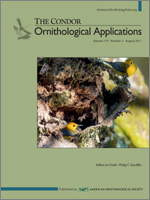Flight Paths is a fine work of journalism, cataloguing the storied history of bird conservation in New York. New Yorkers are pioneers in conservation, and McGrath captures these successes in stories about the people and places responsible for the recovery of the Bald Eagle (Haliaeetus leucocephalus) and Peregrine Falcon (Falco peregrinus). The hallmark of this book is the eloquent detail on the conservation contributions of amateur ornithologists, biologists with the New York Department of Environmental Conservation and the U.S. Fish and Wildlife Service, and academicians at Cornell University and SUNY College of Environmental Science and Forestry. The people contributing to bird conservation in New York are many, and McGrath does quite well to mention all involved. The book also details other threats to the birds of New York (and birds in general), including domestic cats, contaminants in the environment, changing climates, wind turbines, and nighttime illumination, using iconic birds such as the Common Loon (Gavia immer), Short-eared Owl (Asio flammeus), and Bicknell's Thrush (Catharus bicknelli) as a backdrop to each story.
Flight Paths includes 13 chapters divided into five parts. Centered around the loss of Bald Eagles and Peregrine Falcons from DDT and their subsequent recovery—made possible only by the passionate, hardworking, and knowledgeable conservationists of New York—the information contained within will certainly be of interest to amateur and professional ornithologists. There is no finer compendium of the history of the recovery of these birds; McGrath traveled with the people involved in their recovery and interviewed New York's “bird people” along the way. Part 1 (“Why We Should Care about Birds”) highlights the breeding ecology of Bald Eagles, the cold trek through the snow by biologists Mike Allen and Peter Nye in winter 1976 to witness the last remaining pair of Bald Eagles at Hemlock Lake, Teddy Roosevelt's passion for and contributions to bird conservation, and how subtle but accumulating habitat loss and landscape change is the greatest long-term threat to birds. Part 2 (“The Rescuers”) provides specific details on the Peregrine Falcon Restoration Project and Bald Eagle Restoration Project, hacking towers at Montezuma National Wildlife Refuge, and the tracking of individual released Bald Eagles through time, with the successes (hope) and deaths (heartbreak) deftly described. Descriptions include methods of hacking, tracking, observing, and managing Bald Eagles, methods born in New York that led to the release of 198 birds, resulting in 173 pairs in New York by 2009. Part 3 (“Where Will They Be in One Hundred Years?”) describes the challenges ahead, such as keeping Common Loons common in the Adirondack Park; sustaining grassland birds when there is increasing pressure on these already imperiled ecosystems; and finding hope for Bicknell's Thrush, which is being squeezed out of its narrow mountain niche by climate change. Part 4 (“A Brief and Dangerous Life”) continues the theme of Part 3, expounding on the perils of windows, wind turbines, lights, and cats. Part 5 (“The World We've Made”) is a celebration of the successes of bird conservation in New York and beyond, recalling the recovery of the Bald Eagle and Peregrine Falcon. The Epilogue is a call to action for New York State to support endangered species conservation, habitat protection, and contaminant control, and for the people of New York to celebrate their long history of bird conservation as an important and continuing environmental effort.
This book is a useful addition to our libraries because of the detailed history it provides. It is recommended for professionals, academicians, and bird enthusiasts at large. The well-developed notes, bibliography, and index make it a high-quality reference. The Author's Note states that “bird conservation is a vast topic in New York” and that two especially important stories were selected, Bald Eagle and Peregrine Falcon recovery. As such, the overall contribution of New York to bird conservation in totality is missed, and readers should not expect a complete history of conservation successes in the state. Also, there is language sprinkled throughout the book that some may find divisive. For example, speculation on reasons for Bald Eagle mortality at the hands of trappers and turkey hunters uses language that vilifies certain conservation stakeholders, painting an “us against them” image that is unnecessary to the central theme of the book. Mentors of wildlife conservation students could use sections like this in noting how conservationists of all types must work together toward our common goals, and a conservation biology course might use them when describing writing methods to avoid if the long-term goal is welcoming and attracting a diverse group of people to the conservation table. No single book can satisfy all readers. I believe Flight Paths is a good read and worthy of a place on the bookshelf of the “bird people” of New York and beyond.






